Property Edge
Pressing issues affecting homeowners and prospective buyers

Welcome to this week’s edition of the Property Edge newsletter. As we navigate the ever-evolving landscape of Australia’s property market and broader economic environment, it’s essential to stay informed. This week, we delve into the pressing issues affecting homeowners and prospective buyers alike, from the challenges posed by interest rate hikes to the ongoing debates surrounding housing policies. We aim to provide you with insightful analyses and updates to help you understand these complex dynamics and their potential impact on your property decisions.
Australians are grappling with some of the steepest increases in mortgage rates globally, leading to significant rises in debt servicing costs. Unlike many countries that have a higher proportion of fixed-rate mortgages, Australia predominantly utilises variable rate mortgages with shorter fixed periods, usually three years or less.
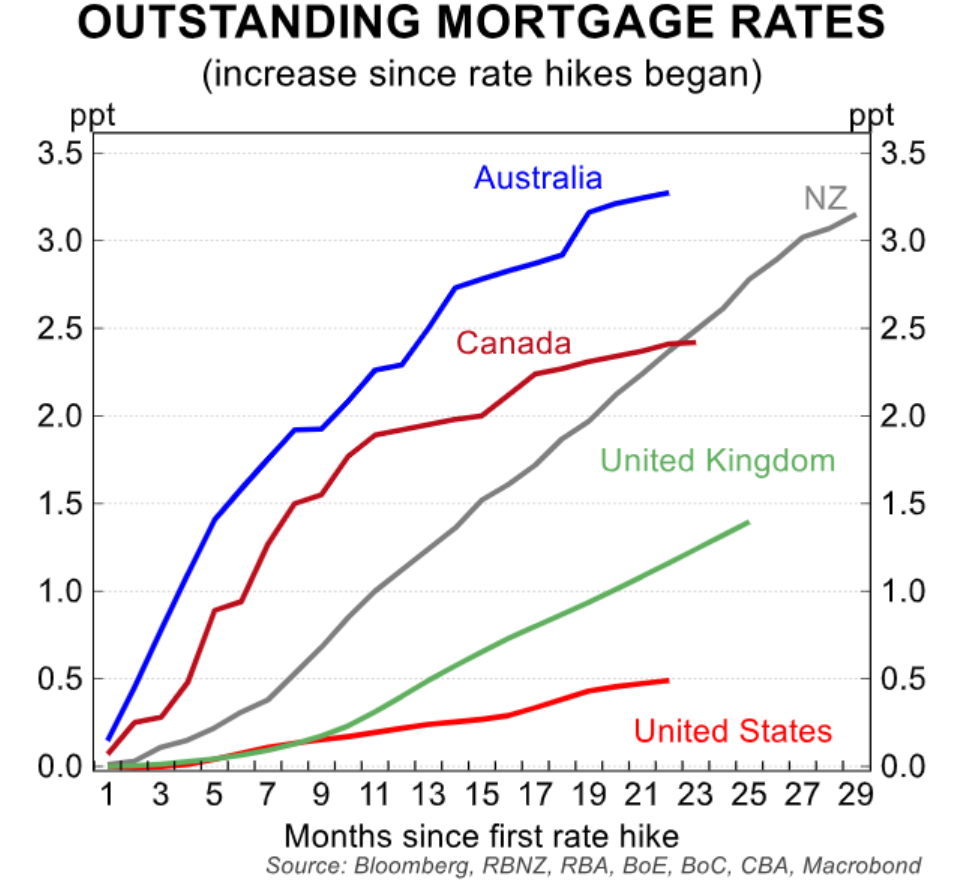
This structure has resulted in Australian mortgage repayments escalating more rapidly than those in other countries, even though the Reserve Bank of Australia (RBA) has raised interest rates to a lesser extent compared to other nations.

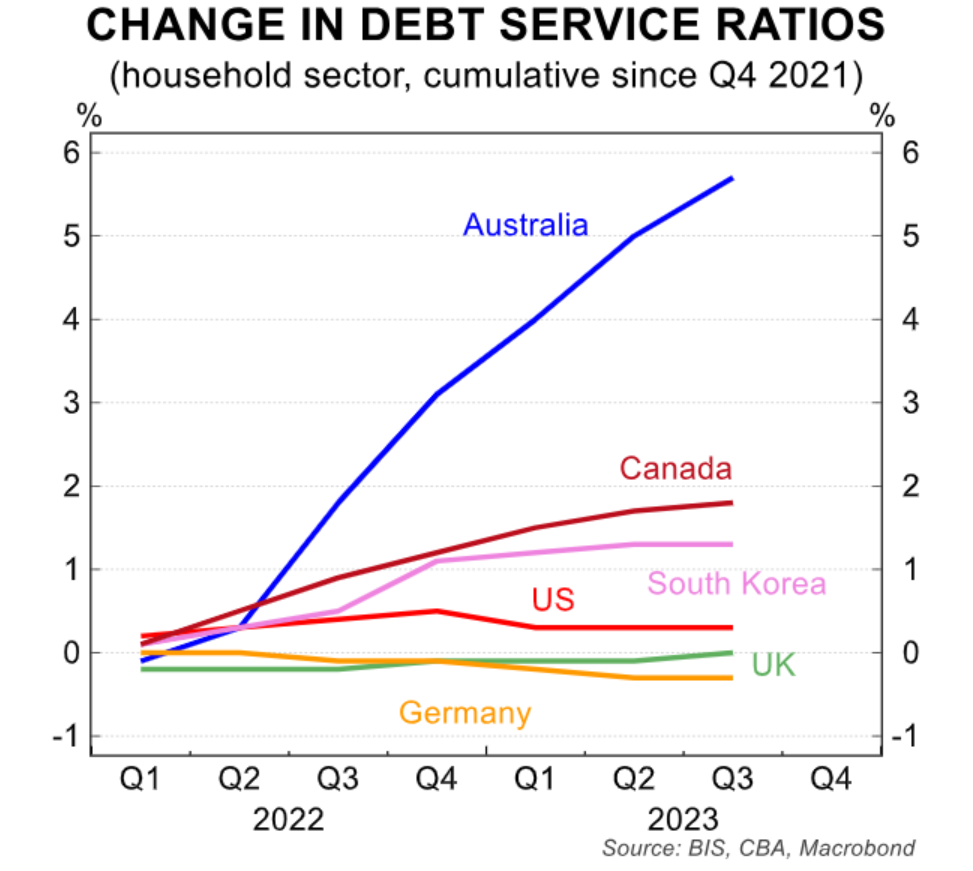
According to Roy Morgan Research, this sharp increase in interest rates has pushed an additional 724,000 Australians into mortgage stress since May 2022, when the RBA commenced its rate hiking cycle. Currently, official interest rates stand at 4.35%, the highest since December 2011.

Roy Morgan’s findings indicate that the number of mortgage holders deemed ‘Extremely At Risk’ has surged to 918,000, which is 18.7% of mortgage holders. This figure substantially exceeds the ten-year average of 14.4%.
However, there is a silver lining as the percentage of Australians experiencing mortgage stress has slightly decreased to 30.3% in March from 31.4%, attributed to stable mortgage rates and growth in household incomes. This improvement suggests some relief for homeowners, though the overall situation remains challenging.
These developments underline the unique vulnerabilities of Australian homeowners to interest rate fluctuations and emphasise the need for financial vigilance in the current economic climate.
Proposed HomeKeeper Government Relief for Mortgage Stress
In response to mounting mortgage stress among Australians, the government is considering a proposal known as the “HomeKeeper” program, inspired by the principle that government intervention may be necessary to help sustain individuals and businesses through tougher times.
Key Features of HomeKeeper:
Purpose: The program aims to help mortgage-stressed owner-occupiers maintain their homes during economic hardships (similar in principle to the JobKeeper program but with improvements proposed as a result of learnings from past experience).
Functionality: Unlike direct financial handouts or loans, HomeKeeper would involve the government taking a small equity stake in properties. This would allow the government to assist homeowners by directly making mortgage payments to banks, up to a modest cap, providing homeowners the breathing room needed to stabilise their finances whilst also providing the government with security for the payment.
Population Target: HomeKeeper is particularly geared towards lower-income families who lack the familial financial support to navigate short-term financial crises.
The program is structured to aid those who are committed to maintaining homeownership but are facing temporary financial difficulties due to current economic conditions.
Economic Justification: The initiative is expected to be cost-effective for taxpayers, as the government’s investment is likely to appreciate in value, reflecting the typical upward trend in property prices. By preventing forced home sales and potential homelessness, HomeKeeper also aims to mitigate broader social and economic costs associated with increased rental demand and homelessness.
Political and Economic Context: With ongoing adjustments in fiscal policy and the persistent challenges of high interest rates, the government is leveraging fiscal tools to influence monetary policy outcomes. Despite these efforts, the anticipated relief from lower interest rates has not materialised as expected.
Support and Criticism:
The proposal has garnered support from various quarters, including crossbenchers who see the direct benefits of such a program in stabilising the housing market and preventing further escalation of rental crises.
Critics, however, might view it as a stopgap measure that doesn’t address the root causes of housing affordability and mortgage stress.
On the issue of new policies and government initiatives, one old controversial chestnut may be rolled out once again:
Negative Gearing Debate Back on the Table
Crossbench senators Jacqui Lambie and David Pocock have asked the Parliamentary Budget Office (PBO) to cost options for possible changes to negative gearing. Senator Lambie claims negative gearing is part of Australia’s housing affordability problem.
There is no cause for panic at this stage though as all the options that the PBO was asked to look at were ‘grandfathered’ so that existing property investors would be unaffected.
- Removing the CGT discount for new rental properties purchased after July 1 and halving it for newly built homes.
- An escalating series of proposals would provide a 25% CGT discount for new homes owned for over three years, remove negative gearing for second and subsequent investment properties, and disallow deductions for vacant homes.
Along with support from the Greens, the federal government needs the help of Lambie and Pocock to pass legislation in the Senate if the Coalition opposes it, and their plan to curb negative gearing for investment properties is claimed to raise $6 billion a year for housing supply.
“Tax reform on its own won’t solve the housing crisis but it can be a powerful tool to drive new supply and should be on the table for sensible debate”, Senator Pocock said.
I no longer view negative gearing as a significant driver of Australian house prices, given New Zealand banned negative gearing on April 1, 2019, and then saw house prices record one of the world’s largest booms over the pandemic.
However, negative gearing skews the property market away from first-time purchasers and costs the federal government a lot of lost income.”
These losses were detailed in the Australian Treasury’s 2023-24 Tax Expenditures and Insights Statement Report:
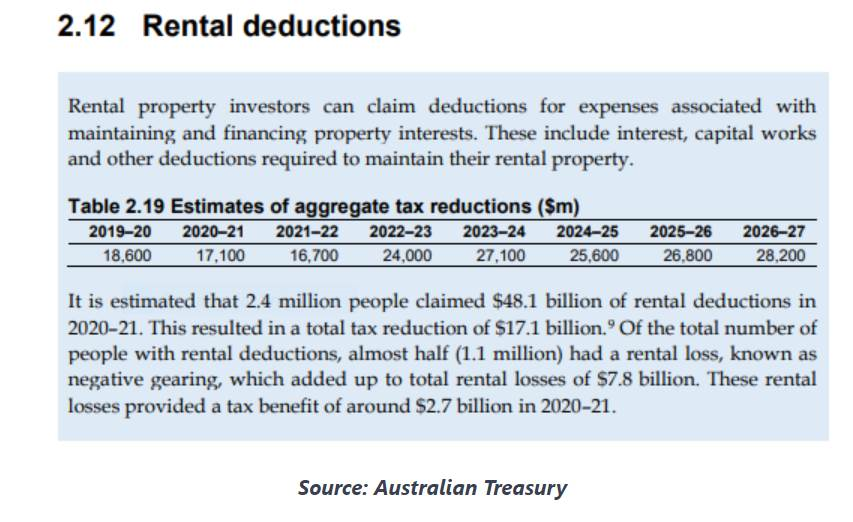
According to the Treasury, “rental losses provided a tax benefit of around $2.7 billion in 2020-21”.
Furthermore, these tax breaks primarily benefit higher-income households:
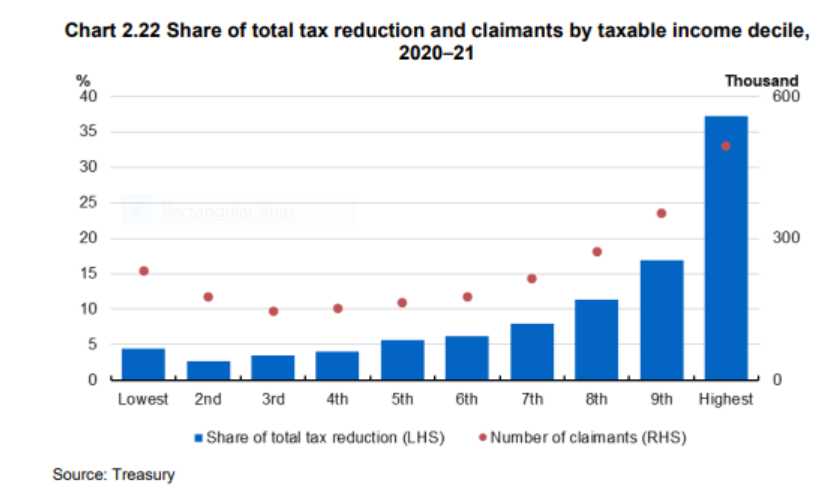
As indicated above, rental losses are forecast to have climbed dramatically since 2020-21 due to the sharp rise in interest rates and investor mortgage payments. As a result, tax benefits will have increased significantly.
The Australian Treasury estimates that the capital gains tax (CGT) discount, which “applies to 50% of any nominal capital gain made by a resident individual or trust where the asset has been owned for at least 12 months”, will cost approximately $25 billion in foregone income in 2022–23:
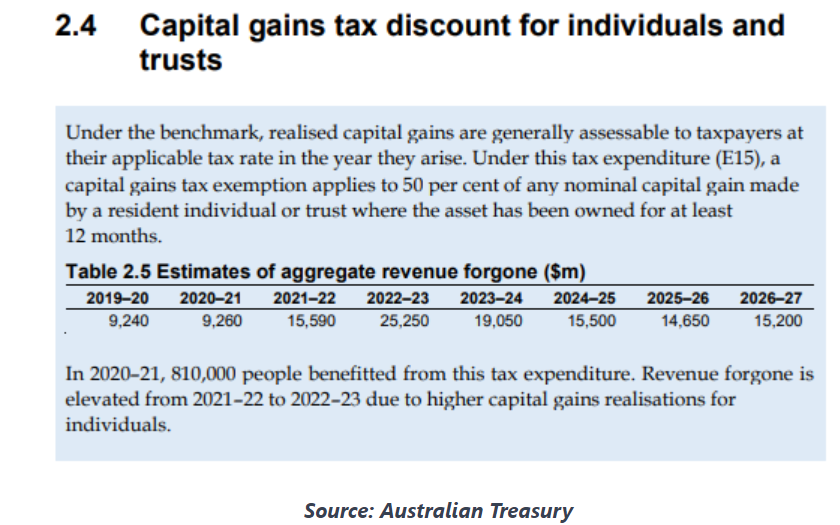
Furthermore, the vast bulk of these tax breaks go to high-income individuals:

However, don’t expect negative gearing reform to impact house prices or rental affordability significantly.
Interest Rate Hikes Have Strained Australian Businesses
On these fronts, the crossbench senators might be better served by examining Australia’s extreme immigration policy, which ensures that housing demand will still keep running ahead of supply. The latest figures in on that front show a clear pattern which significantly impacts the property market in Australia.
Record Temporary Visa Numbers in Q1
The Australian population has seen an unprecedented growth, propelled by a record net overseas migration of 549,000 people in the year leading up to September. In February alone, a historic high of 105,460 net permanent and long-term arrivals was recorded, contributing to a quarterly record of 173,370 arrivals. Over the year, 1,136,770 arrivals were offset by 638,500 departures, illustrating a significant influx.
Data from the Department of Home Affairs indicates a surge in temporary visas, with a total of 2,826,042 temporary migrants present by the end of March 2024, an increase of 366,600 from the previous year and 515,400 more than the pre-pandemic peak in 2019. Excluding visitors, the count of temporary visas stood at 2,421,526.
Significant increases were also seen in specific visa categories:
- Student Visas: Reached a record high with 671,400 on issue, up 58,500 from before the pandemic.
- Graduate Visas: More than doubled the pre-pandemic numbers with 199,900 on issue.
- Working Holiday Maker Visas: A record 183,700 were on issue.
- Temporary Employment Visas: Also hit a record with 325,000 on issue.
- The only category not to hit new records was Bridging visas, which numbered 286,300, slightly below the pandemic peak but showing signs of increase.

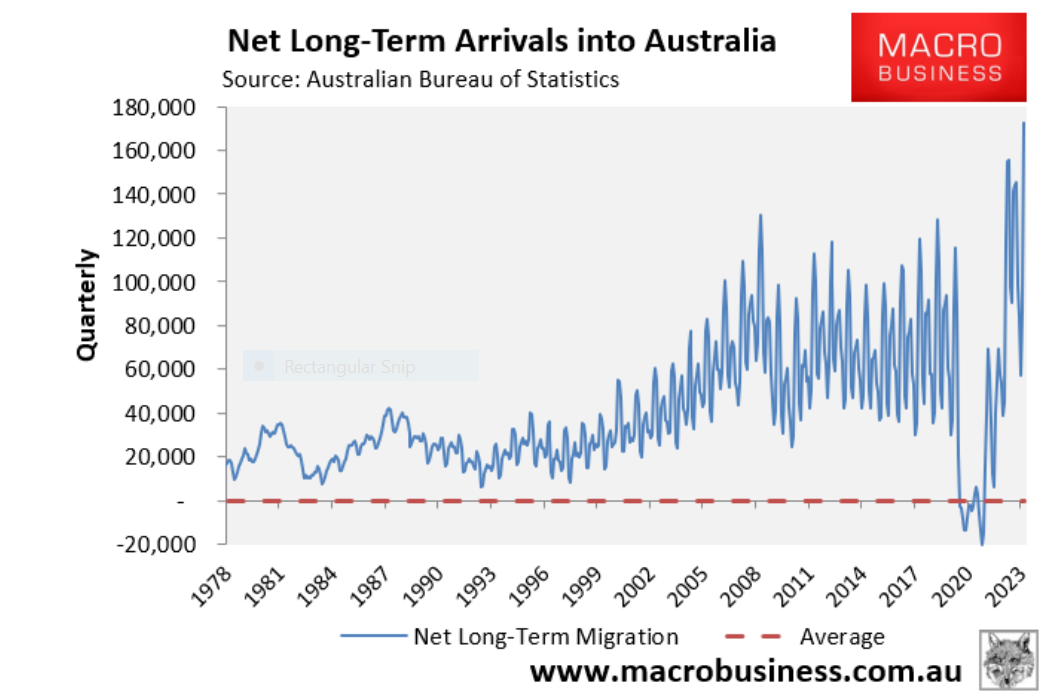

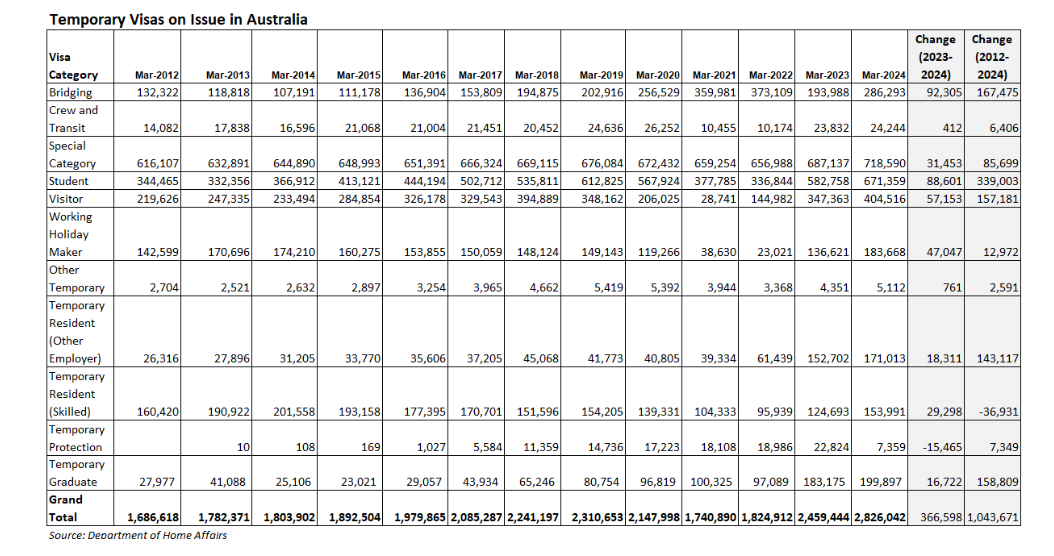
This data starkly contrasts with the December Mid-Year Fiscal and Economic Outlook (MYEFO), which had projected net overseas migration to fall to 375,000 this financial year. The current figures show migration remains at near record highs, posing significant challenges to housing supply and infrastructure in the face of heightened immigration levels orchestrated by the government.
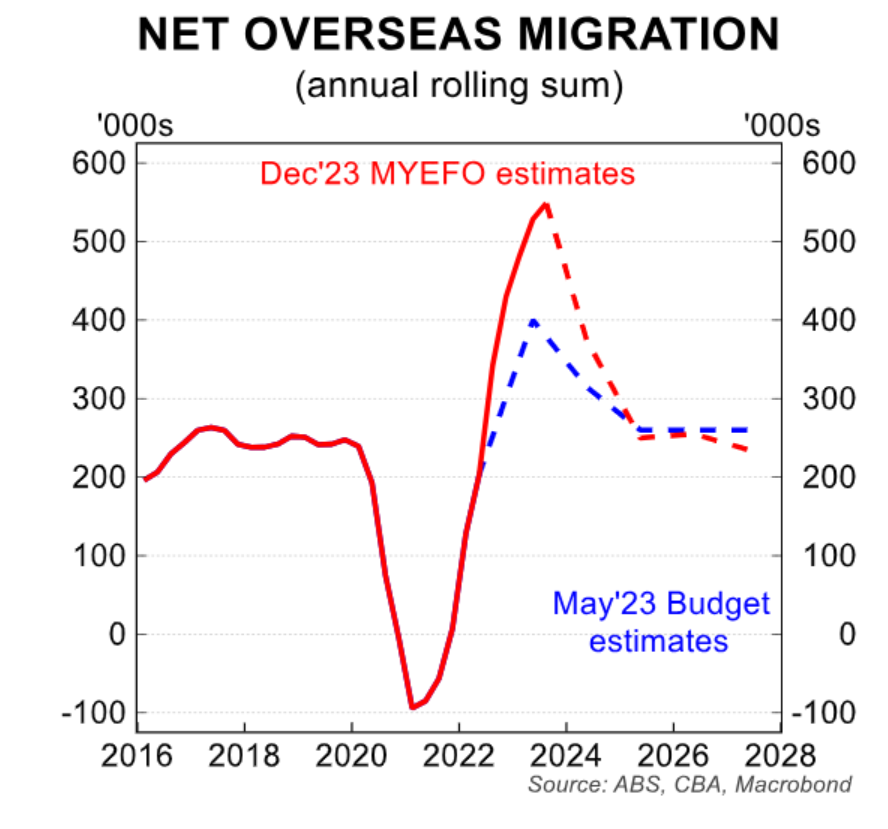
While mass immigration might appear beneficial for migrants from developing countries, offering them better wages compared to their homelands and a pathway to citizenship, economists are concerned that it brings a trio of detrimental effects to the existing Australian population:
- Suppressed Wages: A steady influx of cheap foreign labour undercuts wage growth, directly impacting the earning potential of Australian workers.
- Degraded Public Services: As the population surges, essential services such as housing, education, health care, roads, and public transport struggle to keep up, deteriorating under the strain of increased demand.
- Inflationary Pressures: The imbalance between supply and demand across various sectors not only fuels inflation but also ensures it consistently outstrips income growth, eroding real living standards for Australians.
Arguably these dynamics impact different segments of society in varying ways:
- Elderly and Wealthy: Experience a decline in infrastructure and health services quality.
- Middle-Class Families: Face continual erosion of purchasing power.
- Youth: Potentially suffer the most, grappling with reduced wage prospects and increasingly unaffordable housing.
We can’t change any of these socio-economic and political macro factors but as Property Lovers we can be aware of changes and the opportunities they bring with them if we respond accordingly and provide value to a hungry market.
Thank you for joining us in another insightful journey through the complexities of Australia’s property market. As we’ve explored various factors influencing the current and future state of housing, from government interventions to market trends, it’s clear that staying informed is key to navigating an evolving market. We hope this week’s discussions offer you valuable perspectives as you make your property-related decisions. Remember, the landscape is constantly changing, and we’re here to provide clarity amidst the uncertainty. Stay tuned for next week’s edition for more updates and analyses.
NEW EVENT ALERT: We are running a special ONLINE livestream called ‘The Property Challenge’ on Saturday, 25th May from 9am to 1pm (AEST).
On This Livestream, We Will Show You How You Can Potentially Make $100K In The Next 3 Months And 250K In 12 Months Doing No Money Down Deals Buying Wholesale Properties With The Help Of AI From Distressed Property, Deceased Estates, Developers Under Duress, And Downsizers.
Limited seats! Register now for FREE! Click here for the details..